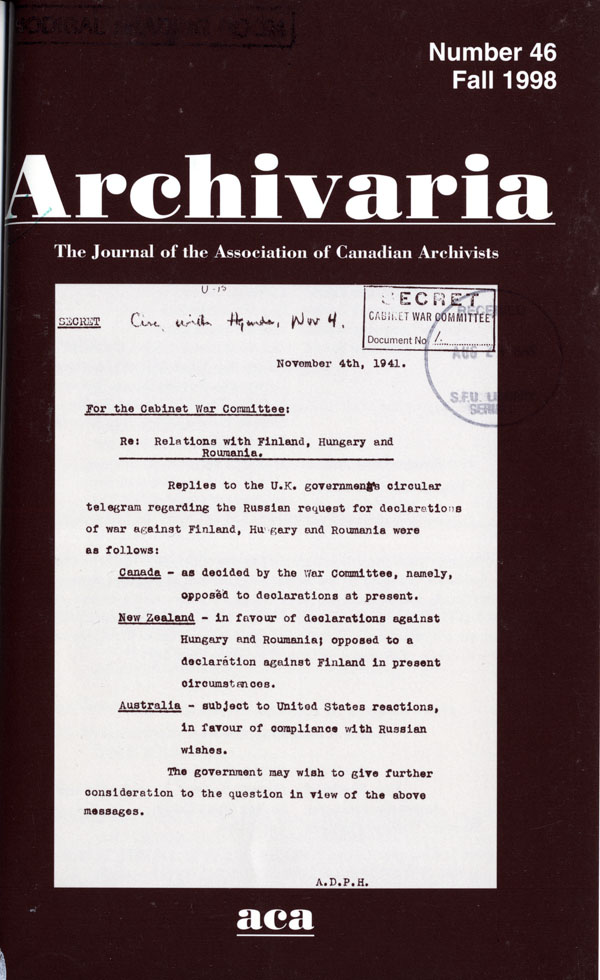Memos and Minutes: Arnold Heeney, the Cabinet War Committee, and the Establishment of a Canadian Cabinet Secretariat During the Second World War
Abstract
Canada’s federal cabinet did not create and maintain records such as minutes until March 1940, when the duties of the Clerk of the Privy Council were amended to include serving in a secretarial capacity to Cabinet. In the context of Cabinet’s long tradition of in camera proceedings, this was a significant development. It was only adopted, at least initially, because of the peculiar circumstances brought on by the Second World War. Simply put, Cabinet needed a more efficient system of making and communicating its decisions because of their urgent nature. The position of Secretary to the Cabinet was thus established so that the Secretary could acquire supporting documentation, create agendas, maintain minutes, and follow up on decisions on behalf of the Cabinet War Committee (which for all intents and purposes replaced the Cabinet during the war). Arnold Heeney was the first person to occupy the amended position of Clerk of the Privy Council and Secretary to the Cabinet. Heeney successfully established a non-partisan secretariat to serve Cabinet basing it on a British precedent – all this despite initial reservations from Prime Minister Mackenzie King. This article examines the evolution of the Cabinet Secretariat and the record-keeping system that it put into place during the Second World War. It then uses this information to gain further insight into the evidence contained in these records.
RÉSUMÉ
Le Cabinet fédéral canadien n’a pas créé ni maintenu d’archives telles que des procès-verbaux avant mars 1940, date à laquelle les responsabilités du greffier du Conseil privé furent alors amendées pour y inclure le secrétariat du Cabinet. Celar eprésentait un développement significatif dans le contexte de la longue tradition desecret entourant les délibérations du Cabinet. Cette décision fut prise, du moins à l’origine, à cause des circonstances particulières imposées par la Deuxième Guerre mondiale. Le Cabinet avait besoin d’un système plus efficace de prise de décision et de communication de ses propres arrêts du fait de leur nature urgente. Le poste de secrétaire fut donc établi pour permettre d’acquérir une documentation justificative, créer des ordres du jour, établir des procès-verbaux et donner suite aux décisions du Comité de la guerre du Cabinet (qui dans les faits se substitua au Cabinet au cours de laguerre). Arnold Heeney fut le premier à occuper ce nouveau poste de greffier du Conseil privé et de secrétaire du Cabinet. Heeney réussit à créer un secrétariat non partisan au service du Cabinet sur la foi d’un précédent britannique et nonobstant les réserves exprimées initialement par le premier ministre Mackenzie King. Cet article examine l’évolution du secrétariat du Cabinet et la gestion des documents qu’il développa aucours de la Deuxième Guerre mondiale. Cette information est ensuite utilisée pour éclairer encore davantage les témoignages qu’offrent les archives du Cabinet fédéral.
Authors of manuscripts accepted for publication retain copyright in their work. They are required to sign the Agreement on Authors' Rights and Responsibilities that permits Archivaria to publish and disseminate the work in print and electronically. In the same agreement, authors are required to confirm that "the material submitted for publication in Archivaria, both in its paper and electronic versions, including reproductions of other works (e.g. photographs, maps, etc.) does not infringe upon any existing copyright." Authors of manuscripts accepted for publication retain copyright in their work and are able to publish their articles in institutional repositories or elsewhere as long as the piece is posted after its original appearance on archivaria.ca. Any reproduction within one year following the date of this agreement requires the permission of the General Editor.





